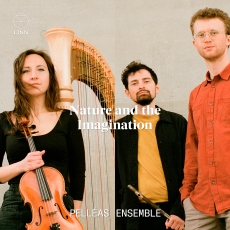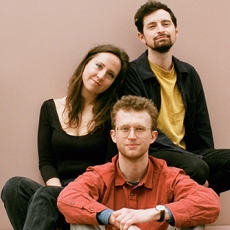Pelléas Ensemble - Nature and the Imagination - Planet Hugill
4.5*
"… music … is limited not to a more or less exact reproduction of nature, but to the mysterious correspondences between Nature and the Imagination" - Debussy, Why I wrote "Pelléas", 1902.
It is Debussy's quote which gives this album its name. Nature and the Imagination on LINN Records is the debut album of the Pelléas Ensemble (Henry Roberts, flute, Luba Tunniclife, viola, Oliver Wass, harp) and features Debussy's Sonata for flute, viola and harp, and Syrinx, Rameau's Deuxième concert in G major, RCT 8 (from Pièces de clavecin en concerts), Sir Richard Rodney Bennett's Sonata after Syrinx, Sir Arnold Bax's Elegiac Trio, Benjamin Graves' Scherzo (which was written for the ensemble), and Gershwin arranged Stephen Roberts A Foggy Day - Love Walked In.
Encouraged by the publisher, Jacques Durand, from 1914 Debussy planned a set of six sonatas for various instruments, in homage to the French composers of the 18th century. But the First World War, along with the composers Couperin and Rameau, inspired Debussy as he was writing the sonatas. The Sonata for flute, viola and harp was written in 1915 and premiered at the New England Conservatory, Boston, USA in 1916.
There is little that is traditional about the piece, its three movements are fluid and at times fragmented, with what can seem a pointillistic use of colour.
The three instruments were chosen partly for their complementary timbres, Debussy's use of them has rather established this trio as something of a standard, witness the fascinating programme that the Pelléas Ensemble has put together, working slowly forward through the 20th and 21st centuries.
The three movements move from the evocative, considered 'Pastorale' through the more flowing 'Interlude' to faster and sometimes busy 'Finale', yet throughout there is a sense of dialogue between the players. Each movement feels like three characters in a room, discussing and passing ideas, sometimes in quite a spare way and always with great regard for the colours and textures of the instruments. There is a beautiful naturalness to the ensemble's performance, avoiding a showy, look-at-me feel, the players inhabit the music and the three interact in a way which feels spontaneous yet well-honed.
Initially, I listened blind to the disc and was intrigued by the work following Debussy's trio, it seemed fascinatingly modern yet also 18th century. In fact, we have the ensemble's arrangement of Rameau's Deuxième concert in G major from the Pièces de clavecin en concerts, his 1741 publication which combined a fully written out harpsichord part with two instrumental parts that 'play along' with the keyboard. For this arrangement, the trio has moved back to something closer to three independent parts, and the simple fact of replacing harpsichord by harp brings a magical effect to the three movements. Throughout, I was astonished at how modern Rameau's writing feels, especially in a performance like this full of imagination, colour and style. Given Debussy's own debt to earlier composers, this piece of programming is a brilliant idea, wonderfully conceived and executed.
Next we return to Debussy for his solo flute piece, Syrinx from 1913 which is related to the myth of the amorous pursuit of the nymph Syrinx by the god Pan, in which Pan falls in love with Syrinx, however, as Syrinx does not return the love to Pan, she turns herself into a water reed and hides in the marshes. Pan cuts the reeds to make his pipes, in turn killing his love. Here we have Henry Roberts giving a superbly liquid performance, langorous and seductive yet with an edge to it too.
Richard Rodney Bennett's Sonata after Syrinx takes Debussy's piece as its starting point and then subjects Debussy's music to the sort of transformations through which Syrinx goes in the myth, almost telling the story through music. It was written for the Nash Ensemble, for their Wigmore Hall concert in 1986 marking the composer's 50th birthday, and its inspiration arose directly out of Richard Rodney Bennett's desire to write for the same combination of instruments as Debussy's sonata. Syrinx had a clear fascination for Bennett as he wrote other works inspired by Debussy's piece After Syrinx I (1983) for oboe and piano, and After Syrinx II (1984) for marimba, and Tango after Syrinx for piano.
We begin with spare textures as Debussy's original Syrinx is evoked, but then with three instruments the chamber dialogue mood of Debussy's sonata comes across, with Bennett relishing the textures and colours. Fast and furious at times, the music develops a spiky intensity with some remarkable moments as it moves further away from Debussy to the different harmonic world of the closing pages.
Written in 1916 and so very close to Debussy's Sonata for flute, viola and harp, Arnold Bax's Elegiac Trio was premiered in 1917 by the same ensemble that had given the UK premiere of Debussy's sonata. But though there may seem to be influences, it seems unlikely that Bax could have known the score of the Debussy so quickly after its composition. Elegiac Trio is one of three works that Bax wrote in the light of the 1916 Dublin Easter Rising, but there is no anger here, simply the singing of the flute and viola to the bardic playing of the harp. It is a melancholy piece, yet full of imaginative writing and gorgeous colours and timbres.
Benjamin Graves' Scherzo was written for the ensemble in 2017 and moves us into another work. It is an intriguing, large-scale work and whilst the music starts off in the character of a Scherzo, the composer's fascinating with more advanced and extended techniques on the instruments ensures that the sound-world is a new one. Liquidity is gone, and the three characters in a room are having an intense, sometimes dramatic and sometimes animated conversation.
Finally, something a bit lighter, Stephen Roberts' arrangement of two songs by George Gershwin, but here with a distinctly French tinge.
This is a wonderfully imaginative programme with the different works playing off each other in numerous ways. On paper the list of composers might seem curious, but the connections and links between them, the complementary nature of the music and the sense of one composer looking back or across at another is really highlighted. But what comes over above all is the playing of the ensemble, vivid and responsive when it needs to be with a natural feel to the interplay of the instruments, we sense we are overhearing three familiar friends in a lively yet relaxed continuing dialogue.

